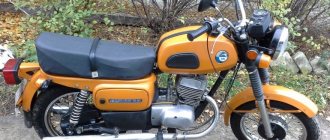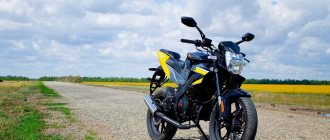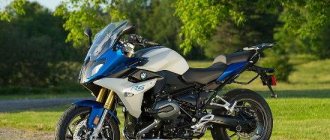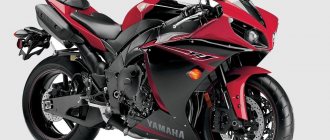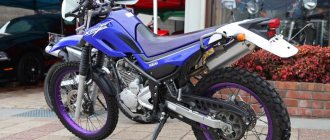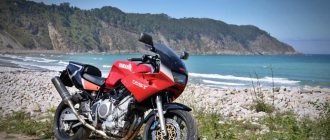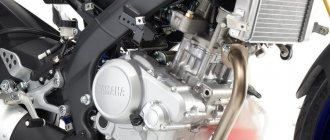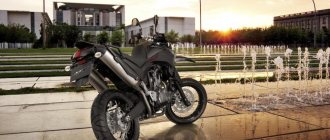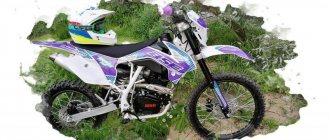The main goal of a first-season motorcyclist is to survive. Neither a powerful chopper, nor fast sports, nor driving skills in the Urals in your grandfather’s village will help you master driving techniques in a metropolis. Learn to change lanes in traffic, fit between rows, maneuver freely and calculate the road situation - for this, a beginner does not need a fast car or a chrome-plated beauty. The purpose of the first motorcycle is to teach and give joy. The joy of owning an iron horse, the headwind in your face and the endless horizon of roads that open up for you.
No one knows for sure how many thousands of newcomers the Yamaha YBR 125 has “trained” and successfully released into the motorcycle world over the course of more than ten years. Affordable price, ease of operation, ideal weight and dimensions make the Ebrik the undisputed market leader among educational and small-capacity motorcycles.
Advantages and disadvantages of Yamaha YBR 125
What allows a Chinese-assembled dairy road builder to remain stable on the Russian market for more than a decade?
The Yamaha YBR125 motorcycle has been produced from 2004 to the present, and is deservedly positioned as an inexpensive motorcycle for study, or as a light road bike for beginners. Let's take a look at the insides of the ebrik:
- Engine capacity – 125 cc;
- Number of cylinders – 1;
- Four-stroke engine;
- The gearbox is 5-speed;
- Drive system – chain;
- Length – 1980;
- The front tire size of Yamaha YBR125 motorcycles is 2.75-18 42P, and the rear tire size is 90/90-18 M/C 57P;
- It weighs 122-125 kg. depends on the model;
- Minimal body kit.
Everything is kept as compact as possible for its class: electronic and kick starter, air-cooled engine with a capacity of 10 horsepower. It will not look for surprises in the design and chassis - a diagonal frame made of steel, a telescopic front fork, with double shock absorber. The brakes are classic: front disc, hydraulic, and rear drum.
As a result of 4 generations, the result was an ideal device: reliable in operation, unpretentious in maintenance and repair, economical in consumption, maneuverable and easy to operate. Add the cost, which corresponds to the quality, and you will understand why demand does not fall, and the Yamaha YBR 125 technical specifications that we cited above remain on the assembly line for so many years. The Japanese concern's focus on simplicity has paid off.
It took me three days to write a review about the Yamaha YBR125 model, after three seasons.
Similar models
Currently, there are quite a lot of small motorcycles in the 125 cc class on the market. The motors of other models are approximately similar in parameters, only the build quality differs. Many owner reviews and reviews show that the Yamaha EBR 125 is the most practical in its category.
However, if you want to save money, you can consider purchasing similar motorcycles, for example: Cobra Crossfire 125, Baltmotors S1 or Guowei GW125. Keep in mind that even a newly supported ebrik will be more reliable than any of these new motorcycles.
Yamaha YBR125 motorcycle. The quieter you go, the further you'll get
YBR125, although produced in China, is controlled by a Japanese concern. Like all “Japanese” cars, it is designed for driving, not for repairs. And the use of our roads could not “kill” the Yamaha during my test drive. I will give the opinions of other users at the end of my story, in the “Yamaha YBR 125 reviews” section.
So, in order. In the fall, the Honda Steed 400 was finally disassembled and sold for parts, but I didn’t want to miss the season at all. Sports and endurikes did not attract me, and the most similar to the classic and cheapest in price was the Yamaha YBR 125, the features of which forced me to consider it in more detail. The semi-fairing and the dashboard with two glasses give the motorcycle the very desired appearance. The seating position turned out to be surprisingly comfortable, and the first hours on the road confirmed that I had made the right choice.
At home, the first thing I had to do was adjust the idle speed. With factory carburetor settings, a Yamaha YBR125, produced in 2006, is only suitable for the first lesson in a driving school. Acceleration at the start is positive, and maneuverability in between rows confirms the title of “Traffic Killer”; even on a scooter there is no such efficiency when passing through traffic jams.
The motorcycle moves through potholes softly and impressively, as if not noticing them on the road, the suspension behaves smoothly, but this is up to 60 km/h. Shock absorbers, in general, work 70% percent. A couple of days later, after the first evening trip, I had to disassemble the fairing and adjust the headlight myself. A little later, I replaced the standard headlight with a lensed one.
When on the highway you want to turn the throttle all the way, you immediately stumble over short gears and the number 100 on the speedometer. Yobrik, as it were, accustoms you to a calm driving regime, hinting that you will never be late for your wake. These are the technical characteristics of the Yamaha YBR125 motorcycle.
Video
Motorcycle Yamaha YBR 125
can confidently be called a modern legend of the motorcycle industry. Tens and hundreds of thousands of novice motorcyclists around the world learned to ride it. With all this, the YBR125 is an absolutely complete motorcycle. Japanese designers made a real breakthrough in their time, combining in one motorcycle the maximum budget and such advantages of a real motorcycle as reliability and endurance.
Currently, this bike is assembled in China under the auspices, but this has not made it worse - quality control at the enterprise is obviously at the level. At the same time, the Yamaha YBR 125 was and remains the cheapest of the Japanese motorcycles. Before the 2014 crisis, you could buy a new motorcycle in a showroom for about 80 thousand rubles, and for that money you could get a trouble-free “workhorse”. Motorcyclists who grew up in the USSR, whose acquaintance with two-wheeled motor vehicles began with some “Minsk” or “Voskhod”, which broke down with enviable regularity and at the same time had the dynamics of a garbage cart, can wipe away a stingy nostalgic tear.
Everything about this motorcycle is made as simple as possible, and this is exactly the case when simplicity of design directly correlates with reliability. The Yamaha YBR 125 has a steel diamond-shaped frame, a two-valve single-cylinder 125 cc air-cooled engine, a rear drum brake, a carburetor, a chain drive and a five-speed gearbox. So to speak, an eternal classic in the flesh. The design of the YBR 125 is also very ordinary; the motorcycle cannot be called modern in appearance, but this is not required of it.
The maximum speed of the light bike, which weighs just over a hundred kilograms, is 110 km/h. However, he gains it quite quickly, although no one expects racing records from the most budget-friendly “Japanese” on the market. The 125 cc Yamaha YZF-R125 and Yamaha WR 125 show incomparably better performance, but they also cost several times more than the hard worker YBR 125.
This motorcycle is a working machine, the main task of which is to deliver its owner from point A to point B as cost-effectively as possible. The Yamaha YBR 125 is also very good as a “study desk”. However, some fans of this motorcycle even manage to travel on it, since its power reserve of more than four hundred kilometers without refueling contributes to this. According to reviews from YBR 125 owners, some of them have already put hundreds of thousands of kilometers on the wheels of their motorcycles, and during this time no significant breakdowns have occurred.
Yes, the simplicity of the design, along with the low price, is another trump card of the Yamaha YBR 125. This motorcycle deservedly enjoys the reputation of a phenomenally durable “horse”, and with timely maintenance it can serve for years without requiring attention. Of course, many motorcyclists soon become insufficient with the capabilities this bike has, and they switch to other, more powerful models, but, nevertheless, the YBR 125 firmly holds the palm in the category “the most popular motorcycle for beginners,” successfully competing with the Honda CB 400.
Of course, when buying this bike, you shouldn’t count on any impressive technical characteristics. But if your goal is the most inexpensive and at the same time reliable, trouble-free motorcycle for everyday riding, which will successfully filter through any traffic jams and take you to your destination, no matter what happens, then the Yamaha YBR 125 is the motorcycle for you.
How much does he eat? how long does it take?
The first gear holds up to 30 km/h without loss, the gear pitch is small: from 10 to 20 km. To achieve maximum speed you have to work hard. An experienced biker is annoyed by short gears. For the Yamaha Ybr 125, the maximum speed on a straight line is 110, you can’t squeeze more out of it. Although for him it’s fast. Fairy tales about acceleration to 120 km/h are just fairy tales. But the 125 turns into corners no worse than a “sport” and holds the road perfectly.
I’ll say right away that during the season, the equipment was not noticed with excessive oil consumption. In terms of average fuel consumption on the Yamaha YBR125, the reviews are almost the same, with a small dramatic difference. Outside the city I often lack power; I squeeze everything I can out of the engine. But more than 4 liters per hundred, at speeds above 8000, with such aggressive driving, the consumption did not rise. My usual consumption is 2.8 liters per 100 km. I am pleased with the omnivorous nature of the engine - my experiments with fuel from 92 to 98 over the course of the season had no effect on the engine’s performance. The mileage has already exceeded 30 thousand, but the consumption remains the same.
001_MOTO_0910_034
It turned out that in order to prepare a dish that can satisfy the gastronomic needs of absolutely diverse and versatile people, ultra-modern technologies and exotic delights of famous restaurant chefs are not at all required. For most, the fundamental principle is still “cheap and cheerful.” How else can we explain that the simple and unpretentious “octagonal” Yamaha YBR125 sold in Europe alone with a circulation exceeding 75 thousand copies? And it’s impossible to count how many of them were sold in Asia and Latin America. Yes, yes, exactly Latin America. After all, the recipe for motorcycle “fast food” appeared in 2000 thanks to the Brazilian branch of the Yamaha Motor do Brasil corporation and was originally intended for the local Spanish- and Portuguese-speaking market: a two-valve single-shaft “single-barrel”, a simple steel frame, minimally sufficient brake mechanisms, simple suspension. Just what you need! The demand for the Yamaha YBR125 was so great that assembly of the model was also organized in Mexico and Colombia. And in 2003, they were joined by a joint venture with the Chinese company Jianshe Industries Co., Ltd in Southeast Asia. It was from there that the lion's share of these motorcycles subsequently came to Europe. It came to Russia even earlier than European countries - in 2004. In general, various modifications of the Yamaha YBR125 for different markets differ significantly from each other: place of production, plastic hitch, brakes, headlights, wheels, power systems. We were imported exclusively carburetor motorcycles from China with a rectangular headlight and a plastic half-fairing. These are what we will mainly be talking about.
And there will be a hole in the old woman
Yamaha YBR-125 review of identified jambs. Let's start with the tires: the standard “Sakura” on models up to the third version left much to be desired. During emergency braking, both wheels drag. The contact area with the road is very small. Therefore, the tires were changed to Michelin a week later. The ebrik holds the road much more confidently, both asphalt and dirt road. Simply great! By the way, since 2008, the motorcycle began to be equipped with five-spoke wheels and tubeless tubes.
It's better not to fall on the Yamaha YBR125. The first fall cost me three thousand rubles. The plastic shattered into pieces. Too fragile and unreliable, like the included tool. Screwdrivers break on first contact. It’s better to immediately assemble your own reliable kit.
The standard brake, in my opinion, deserves only a solid “3”. Emergency braking is possible, but only with experience, and only if you're lucky. Within a month, I replaced the flimsy original one with a reinforced brake hose.
The gearbox lug must be taken care of and tightened constantly. Otherwise it will get lost. From the second generation of ebricks, the problem was eliminated by changing the location of the paw. I had to tighten it every week until I had it redone over the winter. The box itself works flawlessly, and, in general, there are no particular complaints about the transmission. Only the chain constantly stretches and asks for replacement after 7,000 kilometers. In models since 2008, an oil seal chain appeared, its resource is indicated up to 18,000 km.
Autumn came, the Yamaha YBR125 carburetor began to act up. As the temperature dropped it was difficult to start. The closer it got to the cold, the more problems became. The Japanese solved this problem, and in the third generation, since 2008, the ebrik received a new heated Mikuni VM22 carb, front fork, brake discs, calipers, and pads.
Weak points, of course, were also found in the chassis. The front fork of the motorcycle breaks in places, causing the motorcycle to peck and dangle along the road. On the advice of experienced comrades, I filled the shock absorber with 15W oil and installed two additional valve springs from the VAZ engine. Now, from pit to pit, the shock absorber manages to decompress and adequately accepts the load even with the second number. I will give a table by year of production of 125s, it may be useful.
- 2004 – 2006 - first;
- 2007–2009 – second;
- 2009 – 2010 - third;
- 2010 – to date – fourth.
Tuning and modifications of Yamaha YBR125
Tuning Yamaha YBR125 is like a drug. The availability of inexpensive spare parts and accessories makes modifications affordable, financially, and very fun. To begin with, I threw out the standard trunk, which had the inscription “no more than 3 kg” on it. My backpack with a tent, sleeping bag and fuel weighs 15 kilograms, and I was not at all happy about losing it on the road. I ordered a new, reinforced tourist trunk with a chrome frame from Ali.
In the nostalgia for the chopper, Steed's fringed leather side cases also found their place. Tuned mirrors of increased size and chrome handles look like original ones. Next season, I plan to change the rear Izhevsk shock absorbers to Honda ones from the SV400. Relatives were taken in the fall, when my friend and I were preparing for our first long-distance trip on the Ebr. The owners' fantasies are amazing. Some people install additional cooling, others use a pendulum on rolling bearings, I’ve also seen YBR-enduro on super “evil” tires.
Yamaha YBR 125 reviews:
I have chosen several reviews that most fully reveal the opinion of the large army of 125 fans especially for you.
“My motorcycle had a problem with carburetors after winter, I bought a tank flushing additive, filled it in, and after 100-150 km, engine performance improved and the problems disappeared. I go, I don’t complain.” (Alexey, Novosibirsk)
“My friend’s father uses a ebrik for fishing trips. He's been driving without any breakdowns for about two years now, and he likes the handling. I only changed the multi-disc clutch and installed tubeless tires.” (Ivan, Moscow)
“Produced in May 2008, the speedometer showed 1020 km. Consumes little gasoline. The two of us drove 90-100 km/h, the consumption turned out to be 2.7 l/100 km. I'm not happy with the tires, but I won't change them for now. For a 35 W light bulb, the light is quite normal and acceptable. The rear shock absorbers are in the 2nd position, but sometimes they can’t handle the passenger, unfortunately.” (Vladimir, Kiev)
“I recommend purchasing. The overall rating of the motorcycle is 4+. He earns his money honestly. The device is simple and reliable. I'm not going to sell. But I’ll install protective roll bars and update the running boards with sensors.” (Mikhail, Kemerovo)
“I’ve been riding for two seasons after getting my license at a motorcycle school. An ideal bike for learning and suitable for almost any beginner. My friend, Nikolai from Krasnodar, generally rode a ebrik comfortably in Africa.” (Olga, Krasnodar)
“This UBR is an excellent device. With moderate maintenance it will last a long time. Really fast for its class: one cylinder is enough for it. I only had problems with the ignition."
Fourth generation. It's getting steeper and steeper...
Due to strange circumstances, the new model, the 4th generation Yamaha YBR125, is not for sale in Russia. You can only buy a Euro, produced from 2010 to 2016, with mileage, from Japan or Europe. This problem does not stop 125 fans. The price for a 2016 motorcycle without mileage in the Russian Federation is approximately 150,000.00 rubles. Not that much money for a dream.
I was lucky to drive a 2013 125 a couple of times, which my neighbor brought from Japan this spring. Having admired the Yamaha YBR 125 photo enough, studied the innovations on the forums far and wide, I got on the motorcycle with a little excitement.
Of course, it differs from previous models, primarily in its more cheerful design and more ergonomic and durable plastic. On the subject of Yamaha YBR125 technical specifications, number 4, which ignite everyone's curiosity:
- an injector has appeared, making starting easier at any temperature,
- added gear engaged indicator,
- a choke button was placed on the steering wheel,
- added a glove compartment under the seat
- the leading star has undergone changes,
- the brakes and the appearance of the rear turn signals have been improved,
- the front brake became two-piston.
A little history of the model
Since the introduction of Yamaha YBR 125 motorcycles, they have undergone many improvements and changes, becoming better and more reliable.
Yamaha YBR 125 first generation
2004 – launch of sales of the first generation Yamaha YBR 125. In Russia, only versions with a trapezoid-shaped headlight and semi-fairing were sold. Features of this generation are:
- The wheels are three-spoke, tube tires.
- The gearbox pedal is short in length, which is inconvenient to use for people with large feet.
2007 - the second generation motorcycles were launched on sale, which did not change much in appearance, but they changed technically:
- The carburetor was improved, so that idle speed was easier to regulate.
- The gearbox pedal has been lengthened.
- Swapped out the dark gray color for light gray and the stickers on the plastic.
Yamaha YBR 125 third generation
2008 - the modified third generation Yamaha EBR 125 went on sale, this time the motorcycle is already noticeably different from its predecessors. It had the following features:
- The wheels are five-spoke, tubeless tires.
- Heated carburetor.
- Chainring with mounting holes located in different locations, but the same size as before.
- On the rear fender, the location and method of attaching the turn signals has changed (attached using plastic clips). The turn signals themselves have become more streamlined and compact.
- The low beam began to turn on automatically when the ignition was turned on.
- A sensor for the side stand not being retracted appears on the panel.
- The brake pads, calipers, discs, front forks, mirrors and colors were also updated.
2010 - the company developed the fourth generation YBR 125 motorcycle. It has a significantly updated appearance, but these motorcycles are not supplied to Russia.
Kind of like a finale
Yamaha engineers meticulously perfect the 125. And, as we know, there is no limit to perfection. If it weren’t for my love for big, chrome-plated monsters, I would, of course, buy the fourth model. I won’t sell my little one, there is a place for it in my garage, and I have time to take it for a “walk”.
As a first bike, the YBR125 is ideal for some people (riders). For regular trips around the city, a temporary replacement or a “second” motorcycle, there is no need to look for the best option. It simply doesn't exist.
If speed is not your main desire when traveling, if you need nimble, economical and easy-to-repair equipment that still looks decent on the road, then this is your option. A sales leader, as the best budget motorcycle, honestly earning every ruble invested in it, loyal to any tuning, the Yamaha YBR 125 of any generation will become your Friend.
Of course, this is just my personal opinion. Take care of yourself, friends, and good luck on the roads!
Video test drive
Specifications
| Maximum engine power: | 10 HP |
| Torque: | 10 Nm |
| Working volume: | 124 cm3 |
| Motor type (cylinder arrangement, number of strokes): | |
| Number of valves: | |
| Intake type (Injector / Carburetor): | |
| Bore and stroke: | |
| Starting system (Electric starter, kick starter): | |
| Maximum speed in km/h: | 120 km/h |
| Cooling system: | Air |
| Transmission (gearbox): | 5 |
| Clutch (Dry / Wet): | |
| Drive unit: | Chain |
| Frame: | Steel diamond-shaped |
| Chassis | |
| Suspension (front/rear travel): | |
| Brakes (Front/Rear): | |
| Wheels / Tires / Rubber: | |
| Dimensions and weight | |
| Dimensions (Length / Width): | |
| Seat height: | |
| Ground clearance: | |
| Curb weight: | |
| Wheelbase: | 1290 mm |
| Weight: | 125 kg |
| Fuel tank capacity: | 13 l. |
| Battery capacity: | |
| Year of release: | |
| Country of Origin: |
011_MOTO_0910_034
POWER UNIT. A real success for Yamaha designers. The engine has been tested by time and barbaric operating conditions on the roads of the “third world”, and therefore has long been cured of most “childhood diseases”. The owners make up legends about its reliability and unpretentiousness, citing as weighty arguments the hundred and fifty thousand mileage and autonomous circumnavigation of some copies without major repairs. Needless to say, the engine consumes and easily digests almost any fuel and oil. If only the oil itself was changed at least once every 4,000 kilometers. At the same time, the oil-guzzling characteristic of some Yamaha models sometimes appears when the odometer exceeds 35 thousand kilometers, and disappears again with the replacement of piston rings and valve bushings. So it's no surprise that the YBR125 isn't the only bike in Yamaha Motors' slender line-up to use this engine. This list is impressive: XT125R/X, TT-R125, DT125RE, XTZ125E/XE. Some third-party manufacturers did not disdain the motor either (for example, Sherco CityCorp 125).
By the way, wide unification with Yamaha off-road models has one extremely positive side effect: for this engine there are several options for increasing the displacement from the standard 123.7 cm³ to a soul-warming 130–170 cm³. Similar tuning kits (for example, ProCycle, BBR Motorsports or Powroll) include a new cylinder-piston group, a camshaft with extended valve timing and sometimes even a crankshaft with an increased piston stroke. And in order to fully unleash the potential of the engine, you can at the same time install a new Keihin or Mikuni VM26 carburetor with a Ø26 mm diffuser and an engine control unit made by BBR Motorsports, which raises the upper limiter response zone by 1000 rpm. However, you will have to tinker with the release yourself, since the commercially available versions of complete systems for the TT-R125 or XT125R/X on the YBR125 will only fit at the point of attachment to the cylinder head. But the final result should be worth all the pain, because the engine will add about 5-7 “horses” to the existing ten. Some archaic design of the power unit is manifested in the requirement to inspect the thermal clearance of the valves every 6000 km. Neglecting service intervals leads to increased rattling noise from the cylinder head. But you shouldn’t be too afraid: the openness of access to the valves and the simplicity of the adjustment mechanism (screw - nut) make the already simple procedure elementary. But another characteristic noise from the cylinder head should alert you. Due to overheating, it may be necessary to replace crackling camshaft bearings. You can’t delay repairs - the “wedge” of the bearing and the subsequent meeting of the valves with the piston will cost many times more.
